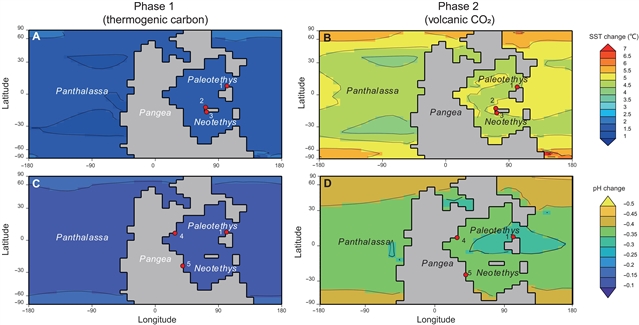
该课题组在一个地球系统模型中同化了大气Pco2和碳酸盐δ13C的重建,以揭示整个二叠纪末大灭绝的碳排放和来源的历史。该研究团队推断,从具有较慢排放速率的热碳同位素特征的二氧化碳源到较重、更由地幔主导、排放速率增加的火山源的转变。这表明,随着西伯利亚圈闭侵位的演化,二氧化碳的脱气方式发生了变化,这与地球化学代用记录相一致。陆地生态系统扰动的碳循环反馈可能进一步放大了变暖和海洋物种灭绝的严重程度。
据悉,大量的二氧化碳(CO2)排放被广泛认为是二叠纪末大灭绝(EPME)的驱动因素。然而,人们对二氧化碳的释放速率和总量,以及其来源是否随时间变化仍然知之甚少,这就留下了一个关于二叠纪末大灭绝触发因素的关键问题。
附:英文原文
Title: Volcanic CO2 degassing postdates thermogenic carbon emission during the end-Permian mass extinction
Author: Yuyang Wu, Ying Cui, Daoliang Chu, Haijun Song, Jinnan Tong, Jacopo Dal Corso, Andy Ridgwell
Issue&Volume: 2023-02-15
Abstract: Massive carbon dioxide (CO2) emissions are widely assumed to be the driver of the end-Permian mass extinction (EPME). However, the rate of and total CO2 released, and whether the source changes with time, remain poorly understood, leaving a key question surrounding the trigger for the EPME unanswered. Here, we assimilate reconstructions of atmospheric Pco2 and carbonate δ13C in an Earth system model to unravel the history of carbon emissions and sources across the EPME. We infer a transition from a CO2 source with a thermogenic carbon isotopic signature associated with a slower emission rate to a heavier, more mantle-dominated volcanic source with an increased rate of emissions. This implies that the CO2 degassing style changed as the Siberian Traps emplacement evolved, which is consistent with geochemical proxy records. Carbon cycle feedbacks from terrestrial ecosystem disturbances may have further amplified the warming and the severity of marine extinctions.
DOI: abq4082
Source: https://www.science.org/doi/10.1126/sciadv.abq4082
